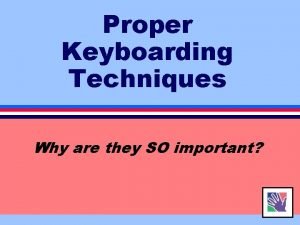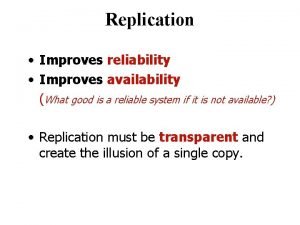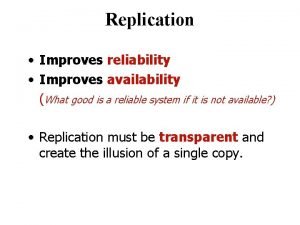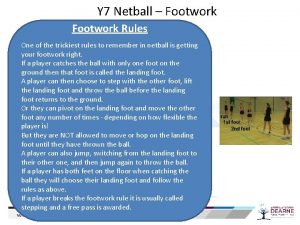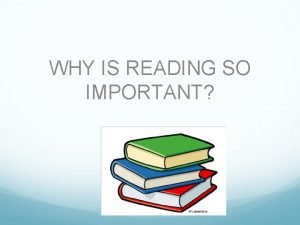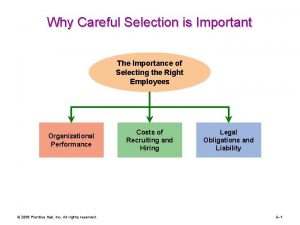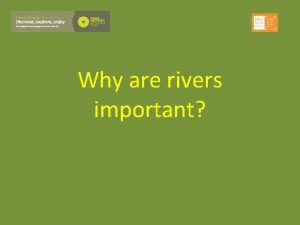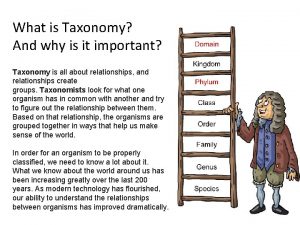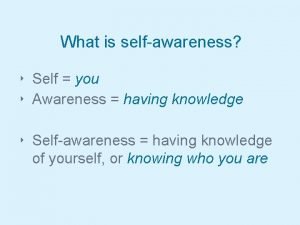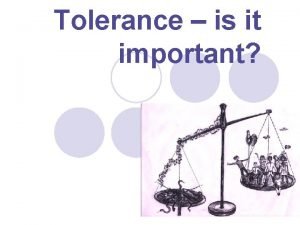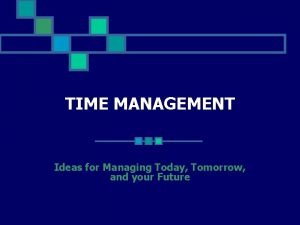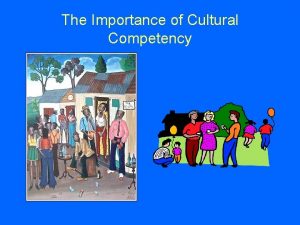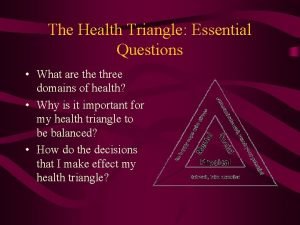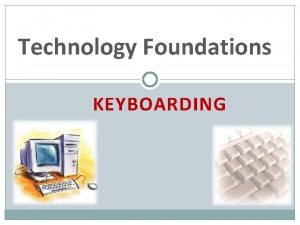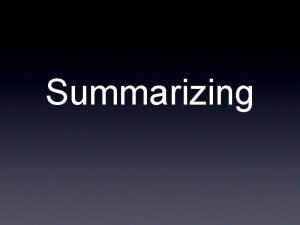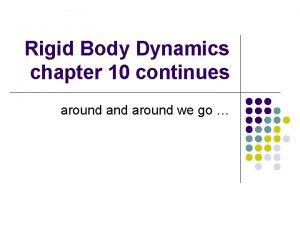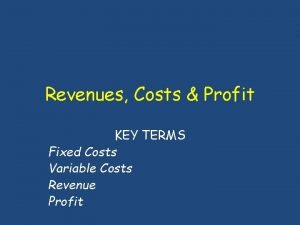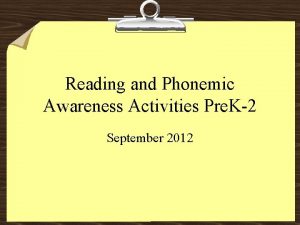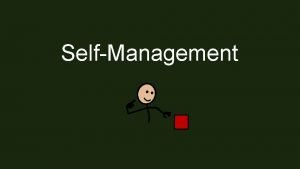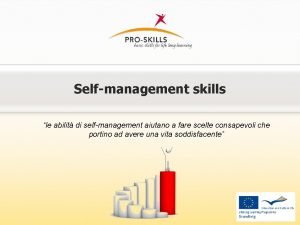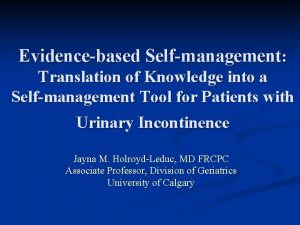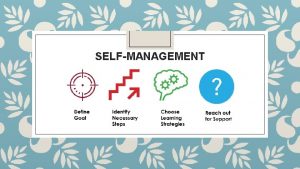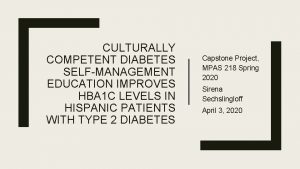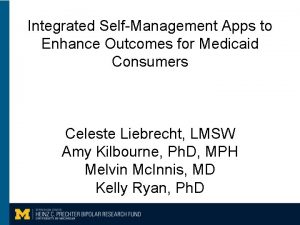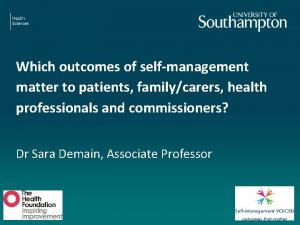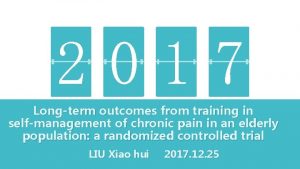WHY IS SELFMANAGEMENT IMPORTANT 1 2 Improves Outcomes
















































- Slides: 48

WHY IS SELF-MANAGEMENT IMPORTANT? 1. 2. Improves Outcomes in Chronic Diseases. It’s weaved into NCQA’s PCMH 2017 Standards: › TC 09 (Core) - A list of resources for patient education and selfmanagement support. › KM 08 (Credit) - self-management resources or other tools to serve the ongoing needs of its population. › KM 22 (Credit) - Self-management tools enable patients to collect health information at home that can be discussed with the clinician. › KM 27 (Credit) - Meeting the patient’s social needs supports selfmanagement and reduces barriers to care. › CM 08 (Credit) - Self-management plans in individual care plans. › CC 16 (Core) - Post-Hospital/ED visit Follow-Up to offer selfmanagement support › QI 04 (Core) - Conducts a patient survey on self-management support

Mike Hindmarsh Hindsight Health Care Strategies and Centre for Collaboration, Motivation and Innovation • Mike is an established healthcare improvement consultant offering strategic planning, project direction, and technical assistance for implementing chronic disease programs in primary, specialty and ancillary care settings. • Mike has worked on over 200 improvement efforts in the last 25 years in Canada, the US, Singapore, Kazakhstan, Mexico and the UK. • Mike expertise includes quality improvement design, measurement and practice coaching. • Mike was formerly the Associate Director, Clinical Improvement under the guidance of Ed Wagner, MD, MPH of the Mac. Coll Institute in Seattle. Along with Dr. Wagner, Mike and his colleagues created the Chronic Care Model - a system redesign strategy to improve the care for chronically ill.

Mike Hindmarsh In-Partnership with Wyoming Primary Care Association May 1, 2019 DELIVERING PATIENT-CENTERED SELF-MANAGEMENT SUPPORT IN PRIMARY CARE

The Chronic Care Model 6 core elements Health System Community 6. Resources and Policies Informed, Activated Patient 1. Health Care Organization 2. Self. Management Support 3. Delivery 4. Decision 5. Clinical Support Information Systems Design Productive Interactions Prepared, Proactive Practice Team Improved Outcomes in Chronic Diseases

TODAY YOU WILL LEARN : 〉 To define Patient and Provider Self- Management support 〉 The importance of Stepped Care using selfmanagement support techniques 〉 About Brief Action Planning: a simple tool for patient-directed goal-setting and action planning 〉 How to Integrate Brief Action Planning into primary care: do’s and don’ts

WHAT IS SELF-MANAGEMENT? 〉 Self-management are the decisions and actions that I take to protect and improve my health and well-being. › Based on Gantz, 1990 Self-Management is Inevitable! 6

WHAT IS CHRONIC ILLNESS SELF-MANAGEMENT? Self-management relates to the tasks that an individual must undertake to live well with one or more chronic conditions. These tasks include gaining confidence to deal with 1. Medical Management, 2. Role Management, and 3. Emotional Management. › Adams, Greiner, and Corrigan (2004) 7

1. MEDICAL MANAGEMENT 8

2. ROLE MANAGEMENT 9

3. EMOTIONAL MANAGEMENT 10

WHAT IS SELF-MANAGEMENT SUPPORT? 〉 The systematic provision of education and supportive interventions by health care staff to increase patients’ skills and confidence in managing their health problems. › Adams, Greiner, and Corrigan (2004) 11

ANOTHER VIEW OF SELF-MANAGEMENT SUPPORT “Self-management support is the assistance caregivers give patients with chronic disease in order to encourage daily decisions that improve health-related behaviors and clinical outcomes. Self-management support can be viewed in two ways: as a portfolio of techniques and tools that help patients choose healthy behaviors; and a fundamental transformation of the patient-caregiver relationship into a collaborative partnership. ” › T Bodenheimer, et al. Helping Patients Manage their Chronic Conditions. Available at http: //www. chcf. org 12

PATIENT EDUCATION SELF-MANAGEMENT EDUCATION Information and skills are taught. Skills are taught to solve patient Topics determined by health care identified problems professionals. Usually disease-specific Skills are generalizable Assumes that knowledge creates behavior change Assumes that confidence yields better outcomes Goal is compliance Goal is increased self-efficacy Teachers are health care professionals Teachers can be professionals or peers Bodenheimer et al JAMA 2002; 288: 2469 13

SELF-MANAGEMENT SUPPORT TOOLS 〉 Action-oriented patient education 〉 Patient-centred goal setting and action planning 〉 Motivational Interviewing 〉 BRIEF ACTION PLANNING

WHAT IS BRIEF ACTION PLANNING? 〉 a highly structured 〉 person-centered 〉 stepped-care 〉 evidence-informed self-management support technique based on the principles and practice of Motivational Interviewing. Reims et al, Brief Action Planning White Paper, 2014 Gutnick et al, JCOM, 2014. available at www. centre. CMI. ca

SPIRIT OF MOTIVATIONAL INTERVIEWING 〉 Compassion 〉 Acceptance 〉 Partnership 〉 Evocation Miller W, Rollnick S. Motivational Interviewing: Helping People Change, 3 ed, 2012

“Is there anything you would like to do for your health in the next week or two? ” Have an idea? With permission: What? When? Where? How often/long/much? Start date? Not sure? Behavioral Menu Not at this time SMART Behavioral Plan Elicit a Commitment Statement “That’s fine, if it’s okay with you, I’ll check next time. ” 1) Ask permission to share ideas. 2) Share 2 -3 ideas. The last idea is one of their own. 3) Ask if any of these ideas might work “How confident or sure do you feel about carrying out your plan (on a scale from 0 to 10)? ” Confidence <7, Problem Solving Confidence ≥ 7 How? When? With whom? “Would it be helpful to set up a check on how things are going with your plan? ” Check on Progress

“Is there anything you would like to do for your health in the next week or two? ”

POSSIBLE RESPONSES TO QUESTION 1 〉 Have an idea 〉 Not sure › Need help with an idea › Need to know what you mean 〉 Not at this time › Healthy › Not interested

SKILL #1 Behavioral Menu Offer a behavioral menu when needed or requested.

Behavioral Menu 1. ASK: “Would you like me to share some ideas that others have used or that might fit for your situation? ” 2. TELL: If yes, share two or three relevant, not too specific, varied ideas ALL AT ONCE. The last idea prompts one of their own. “Some things you might try are ___, ___ or maybe you have an idea of your own that occurs to you now? ” 3. ASK: “Do any of these ideas work for you? ” Healthier Eating Better Sleep Adapted from Stott et al, Family Practice 1995; Rollnick et al, 1999, 2010 Physical Activity

“Is there anything you would like to do for your health in the next week or two? ” Have an idea? With permission: What? When? Where? How often/long/much? Start date? Not sure? Behavioral Menu Not at this time SMART Behavioral Plan Elicit a Commitment Statement “That’s fine, if it’s okay with you, I’ll check next time. ” 1) Ask permission to share ideas. 2) Share 2 -3 ideas. The last idea is one of their own. 3) Ask if any of these ideas might work “How confident or sure do you feel about carrying out your plan (on a scale from 0 to 10)? ” Confidence <7, Problem Solving Confidence ≥ 7 How? When? With whom? “Would it be helpful to set up a check on how things are going with your plan? ” Check on Progress

SKILL #2 SMART Behavioral Plan Action Planning is “SMART”: Specific, Measurable, Achievable, Relevant and Timed. With permission: What? When? Where? How often/long/much? Start date? Based on the work of Locke (1968) and Locke & Latham (1990, 2002); Bodenheimer, 2009

SKILL #3 Elicit a Commitment Statement After the plan has been formulated, the helper/coach elicits a final “commitment statement. ” Strength of the commitment statement predicts success on action plan. Aharonovich, 2008; Amrhein, 2003

“Is there anything you would like to do for your health in the next week or two? ” Have an idea? With permission: What? When? Where? How often/long/much? Start date? Not sure? Behavioral Menu Not at this time SMART Behavioral Plan Elicit a Commitment Statement “That’s fine, if it’s okay with you, I’ll check next time. ” 1) Ask permission to share ideas. 2) Share 2 -3 ideas. The last idea is one of their own. 3) Ask if any of these ideas might work “How confident or sure do you feel about carrying out your plan (on a scale from 0 to 10)? ” Confidence <7, Problem Solving Confidence ≥ 7 How? When? With whom? “Would it be helpful to set up a check on how things are going with your plan? ” Check on Progress

“How confident or sure do you feel about carrying out your plan (on a scale from 0 to 10)? ”

SKILL #4 Problem Solving Problem-solving is used for confidence levels less than 7. Bandura, 1983; Lorig et al, Med Care 2001; Bodenheimer review, CHCF 2005; Bodenheimer, Pt Ed Couns 2009.

PROBLEM SOLVING Confidence <7 “A __ is higher than a zero, that’s good! We know people are more likely to complete a plan if it’s a 7 or higher” Problem Solving: “Any ideas about what might raise your confidence? ” Yes No Behavioral Menu Assure improved confidence. Restate plan and rating as needed.

“Is there anything you would like to do for your health in the next week or two? ” Have an idea? With permission: What? When? Where? How often/long/much? Start date? Not sure? Behavioral Menu Not at this time SMART Behavioral Plan Elicit a Commitment Statement “That’s fine, if it’s okay with you, I’ll check next time. ” 1) Ask permission to share ideas. 2) Share 2 -3 ideas. The last idea is one of their own. 3) Ask if any of these ideas might work “How confident or sure do you feel about carrying out your plan (on a scale from 0 to 10)? ” Confidence <7, Problem Solving Confidence ≥ 7 How? When? With whom? “Would it be helpful to set up a check on how things are going with your plan? ” Check on Progress

“Would it be helpful to set up a check on how things are going with your plan? ” How? When? With whom?

SKILL #5 Check on progress Checking on the plan builds confidence. ü Check often with new action plans and decrease frequency as behaviour is more secure. ü Regular contact over time is better than 1 x intervention. ü Follow-up builds a trusting relationship. Resnicow, 2002; Artinian et al, Circulation, 2010

CHECKING ON PLAN WITH HELPER “How did it go with your plan? ” Completion Partial completion Did not carry out plan Recognize success Recognize partial completion Reassure that this is common occurrence “What would you like to do next? ”

“Is there anything you would like to do for your health in the next week or two? ” Have an idea? With permission: What? When? Where? How often/long/much? Start date? Not sure? Behavioral Menu Not at this time SMART Behavioral Plan Elicit a Commitment Statement “That’s fine, if it’s okay with you, I’ll check next time. ” 1) Ask permission to share ideas. 2) Share 2 -3 ideas. The last idea is one of their own. 3) Ask if any of these ideas might work “How confident or sure do you feel about carrying out your plan (on a scale from 0 to 10)? ” Confidence <7, Problem Solving Confidence ≥ 7 How? When? With whom? “Would it be helpful to set up a check on how things are going with your plan? ” Check on Progress

TIPS FOR USING BRIEF ACTION PLANNING

AVOID THE EXPERT TRAP

THE PERSON DOES MOST OF THE TALKING IN BRIEF ACTION PLANNING (BAP)

AVOID THE ASSESSMENT TRAP

LEARNING “HOW TO” DO BRIEF ACTION PLANNING IS LIKE e c i t c a r P Practice Until. . . Feedb ack You develop self-awareness of skills and become unconsciously competent

HOW BRIEF ACTION PLANNING IS BEING ADVANCED 〉 Through 2018: › CCMI has trained over 2000 people ‧ Nurses in all fields of practice ‧ Physicians ‧ Allied health professionals ‧ Staff of women’s transition houses ‧ Shelter workers ‧ Addictions and mental health workers ‧ Peer counselors for seniors and pregnant women at risk

BRIEF ACTION PLANNING IN PRACTICE: 2015 STUDY LED BY DR AMY CHRISTISON 〉 Examined the impact on goal setting when BAP was combined with the Family Nutrition Physical Activity (FNPA) screening during Well Child visits 〉 Controlled trial with 36 providers having support to use the FNPA but only 19 supported to use BAP

RESULTS 〉 Visits using BAP saw 72% result in an action plan 〉 〉 〉 as opposed to 3. 6% without BAP 56% of the lifestyle goals set were met Providers were more likely to discuss and record issues like weight when combined with BAP Provider satisfaction with the tool was high (3. 8 and 3. 9 of a 5 point rating) When BAP was used patients were more likely to feel the visit was patient-centered Both groups found the intervention easy

BAP AND PCMH Delivering BAP fulfills Core Competency B in the Care Management Section of the Patient Medical Home Standards But is BAP for everyone? PCMH Standards and Guidelines (2017 Edition, Version 4) Pages 64 -65 42

STEPPED CARE SELF-MANAGEMENT SUPPORT Adapted from Health Council of Canada: Self-management Support for Canadians with Chronic Conditions, May 2012 43

SUB-POPULATIONS FOR CARE Good Clinical Control High Self-Confidence Low Self-Confidence Poor Clinical Control

CONFIDENCE SCALE How confident are you that you can manage your health in the next month? Not Confident At all Completely Confident 0 1 2 3 4 5 6 7 8 9 10 Wasson et al: How’s Your Health Survey.

SUPPORT THEM DIFFERENTLY Good Clinical Control High Self-Confidence Low Self-Confidence Poor Clinical Control Usual Care Clinical Care, Action Planning Partnership Interview +

SUMMARY 〉 Self-Management Support is a Core Competency for PCMH designation. 〉 Brief Action Planning is a patient-centered tool to assist patients with behavior change. 〉 The Self-Management Support techniques should be tailored to the patient’s clinical control and willingness to change.

 Hey hey bye bye
Hey hey bye bye How social computing improves customer service
How social computing improves customer service Draw frame machine diagram
Draw frame machine diagram Proper keyboarding technique improves
Proper keyboarding technique improves Replication improves the reliability of the system
Replication improves the reliability of the system Replication improves the reliability of the system
Replication improves the reliability of the system Dont ask
Dont ask Newspaper article format
Newspaper article format From most important to least important in writing
From most important to least important in writing Least important to most important
Least important to most important Why is the ascension important gcse
Why is the ascension important gcse Footwork rule in netball
Footwork rule in netball Items that distort or prevent communication
Items that distort or prevent communication Why experience is important
Why experience is important Strategic plan example
Strategic plan example Why is water important to living things
Why is water important to living things Why reading is so important
Why reading is so important What is meant by physical diversity
What is meant by physical diversity Why careful selection is important
Why careful selection is important Why are rivers important
Why are rivers important What is taxonomy and why is it important
What is taxonomy and why is it important Why is self-awareness important
Why is self-awareness important What is the passover
What is the passover What is advent
What is advent What is ramadan about
What is ramadan about Why are wetlands important
Why are wetlands important Zero based forecasting in hrm
Zero based forecasting in hrm Uml 0..*
Uml 0..* Why is tolerance important
Why is tolerance important Why is time management important
Why is time management important Why is food quality important
Why is food quality important Why is culture important
Why is culture important Why compliments are important
Why compliments are important The health triangle
The health triangle Why is genetic diversity important
Why is genetic diversity important Importance of the sun
Importance of the sun Why is keyboarding important
Why is keyboarding important Why is having a scientific name important
Why is having a scientific name important Important of symbols
Important of symbols Reading
Reading Organic social media
Organic social media Cultural identity
Cultural identity 5 importance of separating mixtures
5 importance of separating mixtures Why is the greenhouse effect important
Why is the greenhouse effect important Work done by torque
Work done by torque Why break-even point is important
Why break-even point is important Define fermentation
Define fermentation Why are refusal skills important
Why are refusal skills important Phoneme substitution
Phoneme substitution



